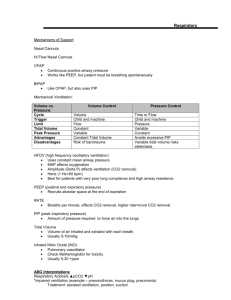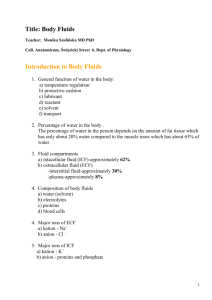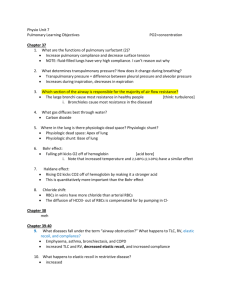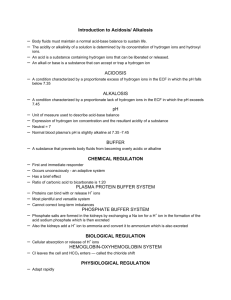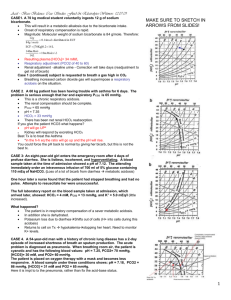Arterial Blood Gas Interpretation
advertisement
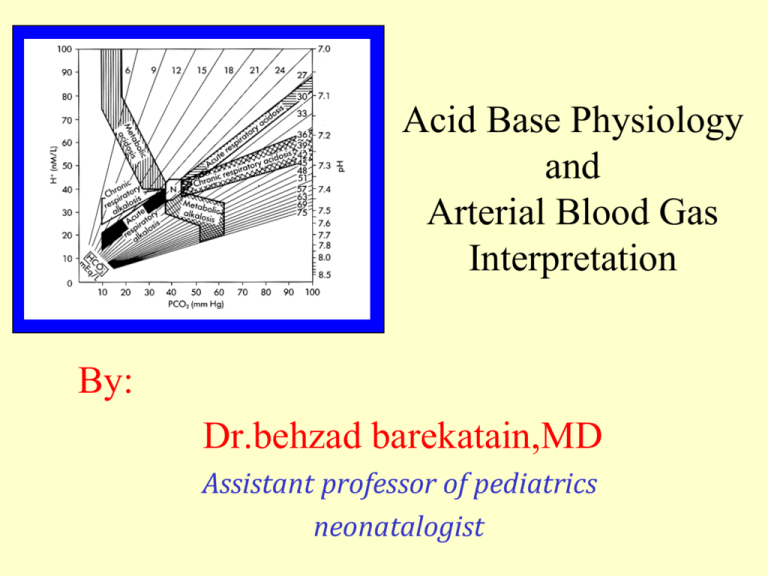
Acid Base Physiology and Arterial Blood Gas Interpretation By: Dr.behzad barekatain,MD Assistant professor of pediatrics neonatalogist Selected Acid-Base Web Sites http://www.acid-base.com/ http://www.qldanaesthesia.com/AcidBaseBook/ http://www.virtual-anaesthesia-textbook.com /vat/acidbase.html#acidbase http://ajrccm.atsjournals.org/cgi/content/full/162/6/2246 http://www.osa.suite.dk/OsaTextbook.htm http://www.postgradmed.com/issues/2000/03_00/fall.htm http://medicine.ucsf.edu/housestaff/handbook/HospH2002_C5.htm Indications for ABG • • • • • • • • • • (1) Severe respiratory or metabolic disorders (2) Clinical features of hypoxia or hypercarbia (3) Shock (4) Sepsis (5) Decreased cardiac output (6) Renal failure (7) Ideally any baby on oxygen therapy (8) Inborn errors of metabolism (9) ventilated infant …………………. INTRODUCTION An arterial blood gas (ABG) is a test that measures the oxygen tension (PaO2), carbon dioxide tension (PaCO2), acidity (pH), oxyhemoglobin saturation (SaO2), and bicarbonate (HCO3) concentration in arterial blood. Some blood gas analyzers also measure the methemoglobin, carboxyhemoglobin, and hemoglobin levels. Such information is vital when caring for patients with critical illness or respiratory disease. As a result, the ABG is one of the most common tests performed on patients in intensive care units (ICUs). The sites, techniques, and complications of arterial sampling are reviewed here, as well as the transport and analysis of the arterial blood. Normal ABG values are provided and a common clinical situation in which the ABG results may be misleading is also described. Interpretation of abnormal ABG values and venous blood gases are also discussed ARTERIAL SAMPLING Arterial blood is required for an ABG. It can be obtained by percutaneous needle puncture or from an indwelling arterial catheter. • A) Needle puncture — Percutaneous needle puncture refers to the withdrawal of arterial blood via a needle stick. It needs to be repeated every time an ABG is performed, since an indwelling catheter is not inserted. Site selection The initial step in percutaneous needle puncture is locating a palpable artery. Common sites include the radial, femoral, brachial, dorsalis pedis, or axillary artery. There is no evidence that any site is superior to the others. However, the radial artery is used most often because it is accessible, easily positioned, and more comfortable for the patient than the alternative sites. 1.The radial artery is best palpated between the distal radius and the tendon of the flexor carpi radialis when the wrist is extended. To get the wrist into this position, the arm should be positioned on an arm-board with the palm facing upward and a large roll of gauze should be placed between the wrist and the arm-board in a position that extends the wrist. Taping the forearm and palm to the arm-board helps maintain the position. 2.The brachial artery is best palpated medial to the biceps tendon in the antecubital fossa, when the arm is extended and the palm is facing up. The needle should be inserted just above the elbow crease. 3.The femoral artery is best palpated just below the midpoint of the inguinal ligament, when the lower extremity is extended. The needle should be inserted at a 90 degree angle just below the inguinal ligament. 4.The dorsalis pedis artery is best palpated lateral to the extensor hallucis longus tendon. It receives collateral flow from the lateral plantar artery through an arch similar to that in the hand. 5.The axillary artery is best palpated in the axilla, when the arm is abducted and externally rotated. There is good collateral flow to the arm through the thyrocervical trunk and subscapular artery; thus, the risk of ischemic complications to the arm is low. The needle should be inserted as high into the axilla as possible Collateral circulation We believe that patients undergoing radial or dorsalis pedis artery puncture should have the collateral flow to those vessels evaluated prior to puncture, even though studies have found variable accuracy associated with such evaluations. Our belief is based upon the notion that the evaluation can be performed quickly at the bedside at no cost and with little risk for harm, but has substantial potential for benefit (ie, to identify patients who have impaired collateral circulation and, therefore, may be at increased risk of an ischemic complication). The Allen test or modified Allen test can be performed in patients undergoing radial artery puncture. These are bedside tests that demonstrate collateral flow through the superficial palmar arch. To perform the modified Allen test, the patient's hand is initially held high with the fist clenched and both the radial and ulnar arteries compressed.This allows the blood to drain from the hand. The hand is then lowered, the fist is opened, and pressure is released from the ulnar artery. Color should return to the hand within six seconds, indicating that the ulnar artery is patent and the superficial palmar arch is intact. The test is considered abnormal if ten seconds or more elapses before color returns to the hand. • The Allen test (from which the modified Allen test evolved) is performed identically, except these steps are executed twice: once with release of pressure from the ulnar artery and once with release of pressure from the radial artery. For patients undergoing dorsalis pedis artery puncture, the dorsalis pedis artery can be occluded, followed by compression of the nailbed of the great toe and assessment of the rapidity with which color returns to the nailbed after pressure is released from the great toe Technique Once a palpable artery has been located, blood is withdrawn using the following steps. 1.The planned puncture site should be sterilely prepped. 2.Local analgesia prior to arterial puncture should be considered, since it appears to prevent pain without adversely impacting the success of the procedure. This was illustrated by a trial that randomly assigned 101 patients undergoing arterial puncture to receive 2 percent lidocaine, normal saline, or no agent prior to the procedure.The lidocaine decreased pain without increasing the difficulty of the procedure (ie, the number of attempts), compared to the other groups. 3.The seal of a heparinized syringe should be broken by pulling its plunger. The plunger can then be pushed back into the syringe, leaving a small empty volume (eg, less than 1 mL) in the syringe. A small needle (eg, 22 to 25 gauge) should then be attached to the syringe. Arterial blood gas kits are available, which contain a heparinized plastic syringe with the plunger already pulled back to allow for the collection of 2 mL of blood without the need to break the seal. 4.Using one hand to gently palpate the artery and the other to manipulate the syringe and needle, the artery should be punctured with the needle at a 30 to 45 degree angle relative to the skin. The syringe will fill on its own (ie, pulling the plunger is unnecessary). Approximately 2 to 3 mL of blood should be removed. 5.To prevent coagulation, the syringe should be rolled between the hands for a few seconds to allow blood to mix with the heparin. 6.After withdrawing a sufficient volume of blood, the needle should be removed and pressure applied to the puncture site for five to ten minutes to achieve hemostasis. Complications Complications due to percutaneous needle puncture are rare. They include: *persistent bleeding *Bruising *injury to the blood vessel *Circulation distal to the puncture site may also be impaired following percutaneous needle puncture, presumably due to thrombosis at the puncture site. . B) Indwelling catheters Arterial blood can also be obtained via an indwelling arterial catheter. Indwelling catheters provide continuous access to arterial blood, which is helpful when frequent blood gases are needed (eg, respiratory failure). Venous blood gases and other alternatives to arterial blood gases An arterial blood gas (ABG) is the traditional method of estimating the systemic carbon dioxide tension and pH, usually for the purpose of assessing ventilation and/or acid-base status. However, the necessary sample of arterial blood can be difficult to obtain due to diminished pulses or patient movement. Diminished pulses may reflect poor peripheral circulation or low blood pressure, while patient movement is frequently caused by the pain associated with arterial puncture. A venous blood gas (VBG) is an alternative method of estimating systemic carbon dioxide and pH that does not require arterial blood sampling. Performing a VBG rather than an ABG is particularly convenient in the intensive care unit, since most patients have a central venous catheter from which venous blood can be quickly and easily obtained. Sampling sites A VBG can be performed using a peripheral venous sample (obtained by venipuncture), a central venous sample (obtained from a central venous catheter), or a mixed venous sample (obtained from the distal port of a pulmonary artery catheter). Central venous blood gases are preferred because their correlation with arterial blood gases is the most well-established by research and clinical experience. Peripheral venous blood gases are an alternative for patients who do not have central venous access.If a tourniquet is used to facilitate venipuncture, it should be released about one minute before the sample is drawn to avoid changes induced by local ischemia. Mixed venous blood gases are a reasonable alternative for patients whose venous access is a pulmonary artery catheter; however, a pulmonary artery catheter should not be inserted for the sole purpose of venous blood sampling Measurements A VBG measures the venous oxygen tension (PvO2), carbon dioxide tension (PvCO2), acidity (pH), oxyhemoglobin saturation (SvO2), and serum bicarbonate (HCO3) concentration: • PvCO2, venous pH, and venous serum HCO3 concentration are used to assess ventilation and/or acid-base status • SvO2 is used to guide resuscitation during severe sepsis or septic shock, a process called early goal-directed therapy • PvO2 has no practical value at this time. It is not useful in assessing oxygenation because oxygen has already been extracted by the tissues by the time the blood reaches the venous circulation. The inability of a VBG to measure oxygenation is the major drawback compared with an ABG. To overcome this limitation, VBGs are often considered in combination with pulse oximetry. Correlation with arterial blood gases Central venous *The central venous pH is usually 0.03 to 0.05 pH units lower than the arterial pH *the PCO2 is usually 4 to 5 mmHg higher *little or no increase in serum HCO3. Mixed venous blood gives results similar to central venous blood. peripheral venous *The pH is approximately 0.02 to 0.04 pH units lower than the arterial pH *the venous serum HCO3 concentration is approximately 1 to 2 meq/L higher *the venous PCO2 is approximately 3 to 8 mmHg higher. There are no venous to arterial conversions for the central venous, mixed venous, or peripheral venous PvO2 or SvO2. Misleading results The correlation between arterial and venous blood gas measurements varies with the hemodynamic stability of the patient. This observation has two practical consequences: First, clinicians should be wary of VBG results and preferentially obtain an ABG in hypotensive patients. Second, periodic correlation of the venous measurements with arterial measurements should be performed whenever venous measurements are used for serial monitoring. END-TIDAL CARBON DIOXIDE Measurement of end tidal carbon dioxide (PetCO2) is another method of non-invasively estimating the arterial carbon dioxide tension (PaCO2). This technique, called capnography, requires a closed system of gas collection, either with a tight fitting mask or a ventilator circuit. A sample of expired gas is analyzed by infrared or mass spectrometry, and then displayed as a numerical value or a graph. The PetCO2 is usually within 1 mm of the PaCO2 in healthy adults, but it is far less accurate in critically ill adults because of the dependence of CO2 production on cardiac output .Thus, routine use of PetCO2 exists primarily in newborn ICUs, operating rooms, and emergency departments, to provide early warning of endotracheal tube complications. PetCO2 is reviewed in detail separately. TRANSCUTANEOUS CARBON DIOXIDE Systems that measure both transcutaneous carbon dioxide (ptcCO2) and pulse oximetry are an attractive option because they overcome the major limitations of both ABGs (invasive arterial sampling) and VBGs (lack of information about oxygenation). Such combination systems generally have a heating element that raises the skin temperature to 42 to 45ºC to increase local perfusion, an electrode to measure ptcCO2, and a light emitter and sensor to measure arterial oxyhemoglobin saturation. Older studies suggested that ptcCO2 measurements are accurate in neonates, but not critically ill adults because of poor peripheral perfusion (peripheral artery disease, hypotension, vasopressors). Devices have since improved and more recent observational studies suggest that the newer systems may be more accurate in critically ill patients, although their accuracy diminishes when the arterial carbon dioxide tension (PaCO2) is greater than 56 mmHg. Such combination systems have limitations: 1.They may be difficult to keep calibrated 2.may be difficult to mount in a way that prevents air trapping 3.may take up to an hour to sufficiently warm the skin. 4.the devices must be attached to an ear, which may be difficult in agitated patients or in those who had neurosurgery Given the limitations of noninvasive monitoring, any persistent or unexpected change in the ptcCO2 or oxyhemoglobin saturation should be confirmed with an ABG. Clinical trials are necessary before combined pulse oximetry and ptcCO2 monitoring become routine care. Comparison of Blood Gas Analysis at different sites • • • • • Arterial PH Same PO2 Higher PCO2 Lower HCO-3 Same Recommendation Good Capillary ---------------------------Fair Venous Lower Lower Higher Same Bad SPECIMEN CARE Regardless of the method used to withdraw the arterial blood, several issues should be considered prior to sending the specimen to the laboratory: 1.Gas diffusion through the plastic syringe is a potential source of error. However, it appears that the clinical significance of the error is minimal if the sample is placed on ice and analyzed within 15 minutes. Using a glass syringe will also prevent this error. 2.The heparin that is added to the syringe as an anticoagulant can decrease in the pH if acidic heparin is used. It can also dilute the PaCO2, resulting in a falsely low value.Thus, the amount of heparin solution should be minimized and at least 2 mL of blood should be obtained. 3.Air bubbles that exceed 1 to 2 percent of the blood volume can cause a falsely high PaO2 and a falsely low PaCO2. The magnitude of this error depends upon the difference in gas tensions between blood and air, the exposure surface area (which is increased by agitation), and the time from specimen collection to analysis. The clinical significance of this error can be decreased by gently removing the bubbles without agitation and analyzing the sample as soon as possible. 4.This reduces oxygen consumption by leukocytes (ie, leukocyte larceny), which can cause a factitiously low PaO2.This effect is most pronounced in patients whose leukocytosis is profound. In addition, it reduces the likelihood that error due to gas diffusion through the plastic syringe or air bubbles will be clinically significant. TRANSPORT The arterial blood should be placed on ice during transport to the lab and then analyzed as quickly as possible. ANALYSIS Analysis of arterial blood is usually performed by automated blood gas analyzers, which automatically transport the specimen to electrochemical sensors to measure pH, PaCO2, and PaO2: • The PaCO2 is measured using a chemical reaction that consumes CO2 and produces a hydrogen ion, which is sensed as a change in pH • The PaO2 is measured using oxidation-reduction reactions that generate measurable electric currents • Automated blood gas analyzers rinse the system, calibrate the sensors, and report the results. Rigorous quality control by the laboratory is essential for accurate results. • Arterial blood gas measurements are effected by temperature. Specifically, pH increases and both PaO2 and PaCO2 decrease as temperature declines. The effect of temperature on blood gas measurements Modern automated blood gas analyzers can report the pH, PaO2, and PaCO2 at either 37ºC (the temperature at which the values are measured by the blood gas analyzer) or at the patient's body temperature. Most centers report the values of pH, PCO2, and PO2 at 37ºC, even if the patient's body temperature is different. However, this practice is controversial Terminology of ABG • Acidemia — An arterial pH below the normal range (less than 7.36). • Alkalemia — An arterial pH above the normal range (greater than 7.44). • Acidosis — A process that tends to lower the extracellular fluid pH (hydrogen ion concentration increases). This can be caused by a fall in the serum bicarbonate (HCO3) concentration and/or an elevation in PCO2. • Alkalosis — A process that tends to raise the extracellular fluid pH (hydrogen ion concentration decreases). This can be caused by an elevation in the serum HCO3 concentration and/or a fall in PCO2. • Metabolic acidosis — A disorder that causes reductions in the serum HCO3 concentration and pH. • Metabolic alkalosis — A disorder that causes elevations in the serum HCO3 concentration and pH. • Respiratory acidosis — A disorder that causes an elevation in arterial PCO2 and a reduction in pH. • Respiratory alkalosis — A disorder that causes a reduction in arterial PCO2 and an increase in pH. • Simple acid-base disorder — The presence of one of the above four disorders with the appropriate respiratory or renal compensation for that disorder. • Mixed acid-base disorder — The simultaneous presence of more than one acid-base disorder. Mixed acid-base disorders can be suspected from the patient's history, from a lesser- or greater-than-expected compensatory respiratory or renal response, and from analysis of the serum electrolytes and anion gap. As an example, a patient with severe vomiting would be expected to develop a metabolic alkalosis due to the loss of acidic gastric fluid. If, however, the patient developed hypovolemic shock from the fluid loss, the ensuing lactic acidosis would lower the elevated serum HCO3 possibly to below normal values, resulting in acidemia INTERPRETATION ABGs provide information about oxygenation, ventilation, and acidbase balance • Acid-Base & ventilation Information • pH • PCO2 • HCO3 [calculated vs measured] • Oxygenation Information • PO2 [oxygen tension] • SO2 [oxygen saturation] Each day approximately 15,000 mmol (considerably more with exercise) of carbon dioxide (CO2, which can generate carbonic acid as it combines with water) and 50 to 100 meq of nonvolatile acid (mostly sulfuric acid derived from the metabolism of sulfur-containing amino acids) are produced. Acid-base balance is maintained by normal pulmonary and renal excretion of carbon dioxide and nonvolatile acid, respectively. General principles in ABG interpretation The Henderson-Hasselbalch equation shows that the pH is determined by the ratio of the serum bicarbonate (HCO3) concentration and the PCO2, not by the value of either one alone. Each of the simple acidbase disorders is associated with a compensatory respiratory or renal response that limits the change in ratio and therefore in PH. pH = 6.10 + log ([HCO3-] ÷ [0.03 x PCO2]) Hydrogen Ions H+ is produced as a by-product of metabolism. [H+] is maintained in a narrow range. Normal arterial pH is around 7.4. A pH under 7.0 or over 7.8 is compatible with life for only short periods. PH and [H+] [ + H] in nEq/L = 10 (9-pH) A normal [H+] of 40 nEq/L corresponds to a pH of 7.40. Because the pH is a negative logarithm of the [H+], changes in pH are inversely related to changes in [H+] (e.g., a decrease in pH is associated with an increase in [H+]). pH [H+] 7.7 7.5 7.4 7.3 7.1 7.0 6.8 20 31 40 50 80 100 160 Hydrogen Ion Regulation The body maintains a narrow pH range by 3 mechanisms: 1. Chemical buffers (extracellular and intracellular) react instantly to compensate for the addition or subtraction of H+ ions. 2. CO2 elimination is controlled by the lungs (respiratory system). Decreases (increases) in pH result in decreases (increases) in PCO2 within minutes. 3. HCO3- elimination is controlled by the kidneys. Decreases (increases) in pH result in increases (decreases) in HCO3-. It takes hours to days for the renal system to compensate for changes in pH. CENTRAL EQUATION OF ACID-BASE PHYSIOLOGY The hydrogen ion concentration [H+] in extracellular fluid is determined by the balance between the partial pressure of carbon dioxide (PCO2) and the concentration of bicarbonate [HCO3-] in the fluid. This relationship is expressed as follows: [H+] in nEq/L = 24 x (PCO2 / [HCO3 -] ) where [ H+] is related to pH by [ H+] in nEq/L = 10 (9-pH) NORMAL VALUES Using a normal arterial PCO2 of 40 mm Hg and a normal serum [HCO3- ] concentration of 24 mEq/L, the normal [H+] in arterial blood is 24 × (40/24) = 40 nEq / L When a primary acid-base disturbance alters one component of the PCO2/[HCO3- ]ratio, the compensatory response alters the other component in the same direction to keep the PCO2/[HCO3- ] ratio constant. PCO2/[HCO3- ] Ratio Since [H+] = 24 x (PCO2 / [HCO3-]), the stability of the extracellular pH is determined by the stability of the PCO2/HCO3- ratio. Maintaining a constant PCO2/HCO3- ratio will maintain a constant extracellular pH. The respiratory compensation: When a metabolic acid-base disorder causes the serum HCO3 to decrease (metabolic acidosis) or increase (metabolic alkalosis), there is usually an appropriate respiratory compensation that causes the PCO2 to change in the same direction as the serum HCO3 (falling in metabolic acidosis and rising in metabolic alkalosis). The respiratory compensation mitigates the change in the ratio of the serum HCO3 to PCO2 and therefore in the pH. The respiratory compensation in metabolic acidosis or alkalosis is a rapid response that, in metabolic acidosis, begins within 30 minutes and is complete within 12 to 24 hours The ventilatory control system provides the compensation for metabolic acid-base disturbances, and the response is prompt. The changes in ventilation are mediated by H+ sensitive chemoreceptors located in the carotid body (at the carotid bifurcation in the neck) and in the lower brainstem. *A metabolic acidosis excites the chemoreceptors and initiates a prompt increase in ventilation and a decrease in arterial PCO2. *A metabolic alkalosis silences the chemoreceptors and produces a prompt decrease in ventilation and increase in arterial PCO2. Control System for Respiratory Regulation of Acid-base Balance Control Element Controlled variable Physiological or Anatomical Correlate Arterial pCO2 Sensors Central and peripheral chemoreceptors Central integrator The respiratory center in the medulla Effectors The respiratory muscles Comment A change in arterial pCO2 alters arterial pH (as calculated by use of the HendersonHasselbalch Equation). Both respond to changes in arterial pCO2 (as well as some other factors) An increase in minute ventilation increases alveolar ventilation and thus decreases arterial pCO2 (the controlled variable). The renal compensation: When a respiratory acid-base disorder causes the PCO2 to increase (respiratory acidosis) or decrease (respiratory alkalosis), there is usually a renal compensation that causes the HCO3 to change in the same direction as the PCO2, thereby mitigating the change in pH. These compensations are mediated by increased hydrogen ion secretion (which raises the serum HCO3 concentration) in respiratory acidosis and decreased hydrogen ion secretion and urinary HCO3 loss in respiratory alkalosis. The renal compensation takes three to five days for completion. As a result, the expected findings are different in acute (little or no renal compensation) and chronic (full renal compensation) respiratory acidbase disorders. Renal excretion of acid is achieved by combining hydrogen ions with either urinary buffers to form titratable acid, mainly phosphate (HPO42- + H+ → H2PO4-), or with ammonia to form ammonium (NH3 + H+ → NH4+) When increased quantities of acid must be excreted by the kidney, the major adaptive response consists of increases in ammonia production (derived from the metabolism of glutamine) with a resultant increase in ammonium excretion into the urine. The compensatory renal and respiratory responses are thought to be mediated, at least in part, by parallel pH changes within sensory and regulatory cells including renal tubule cells and cells in the respiratory center. The magnitude of the compensatory response is proportional to the severity of the primary acid-base disturbance. An important clinical consequence of these compensations is that the diagnosis of an acid-base disorder requires measurement of the extracellular (usually arterial) pH. The diagnosis cannot be made from the serum HCO3 alone. A low value could represent either metabolic acidosis or the renal compensation to respiratory alkalosis, while a high value could represent either metabolic alkalosis or the renal compensation to respiratory acidosis. In addition, mixed acid-base disorders may be present. The expected compensation for any given acid-base disorder has been determined empirically by observations in humans with either spontaneous or experimentally induced simple acid-base disorders The degree of compensation is usually calculated from the decrease or increase in arterial PCO2 from its normal range (in metabolic acid-base disorders) or the decrease or increase in serum HCO3 from its normal range (in respiratory acid-base disorders). This approach presumes that the patient had normal values prior to the onset of the acid-base disorder. Thus, in the absence of known baseline values, there is the potential for error if the patient had abnormal baseline values. Metabolic acid-base disorders 1.Metabolic acidosis *The respiratory compensation to metabolic acidosis results in an approximately 1.2 mmHg fall in arterial PCO2 for every 1 meq/L reduction in the serum HCO3 concentration. *The respiratory response to metabolic acidosis begins within 30 minutes and is complete within 12 to 24 hours. *The lag in respiratory compensation is not seen when the metabolic acidosis develops slowly (eg, 4 meq/L fall in serum HCO3 over 15 hours). *An inability to generate the expected respiratory response is usually indicative of significant underlying respiratory or neurologic disease, but can also be seen in patients with acute metabolic acidosis in whom there has not been adequate time for respiratory compensation to achieve completion. *Several other relationships have been used to determine the appropriate respiratory compensation to metabolic acidosis. These include: • Arterial PCO2 = 1.5 x serum HCO3 + 8 ± 2 (Winters' equation) • Arterial PCO2 = Serum HCO3 + 15 • Arterial PCO2 should be similar to the decimal digits of the arterial pH (eg, 25 mmHg when the arterial pH is 7.25, a setting in which the serum HCO3 concentration would be approximately 11 meq/L) These formulas generally give similar results and there are no data on comparative efficacy A reasonable approach is to use the relationship rule that is easiest to remember and implement. *There is a limit to the maximum respiratory compensation that can be attained. In severe metabolic acidosis (eg, serum HCO3 concentration less than 6 meq/L), the PCO2 can be reduced to a minimum of 8 to 12 mmHg in individuals with normal neuro-respiratory function. *In addition to assessing the respiratory compensation, another component in the evaluation of patients with metabolic acidosis is calculation of the serum anion gap to determine if it is normal or elevated. *Metabolic acidosis may be of the -high anion gap type -normal anion gap type (hyperchloremic) -combined normal and elevated anion gap acidosis. The latter often occurs with severe diarrhea, which generates a normal anion gap metabolic acidosis but can also lead to hypovolemia-induced lactic acidosis With high anion gap metabolic acidosis, comparing the change in anion gap (or the Δ anion gap) with the change in bicarbonate (or the Δ bicarbonate) may be helpful. 2.Metabolic alkalosis The respiratory compensation to metabolic alkalosis should raise the PCO2 by 0.7 mmHg for every 1 meq/L elevation in the serum HCO3 concentration In severe metabolic alkalosis, the arterial PCO2 can be as high as 55 mmHg, suggesting that hypoxia in individuals without underlying lung disease does not usually limit the respiratory compensation • Limitations of the respiratory compensation It has been shown in dog studies that respiratory compensation for metabolic acidosis or alkalosis most effectively blunts changes in pH acutely. If the metabolic disorder persists, on the other hand, respiratory compensation becomes less effective and can even have a detrimental effect on pH The acute hyperventilatory response to metabolic acidosis causes a fall in PCO2 and this will initially raise the arterial pH toward normal. However, over time, the reduction in PCO2 causes a further decrease in the serum HCO3 concentration due to both reduced renal acid secretion and urinary HCO3 loss; these changes are similar to those induced by primary respiratory alkalosis The net effect of these two processes is that they tend to cancel one another out so that the arterial pH with chronic metabolic acidosis is often the same whether or not respiratory compensation occurs. Furthermore, in studies in dogs, the respiratory response was occasionally maladaptive, and the secondary fall in serum HCO3 actually caused the arterial pH to fall below the level that would have existed in the absence of respiratory compensation. Analogous findings have been demonstrated in chronic metabolic alkalosis in which the respiratory compensation (hypoventilation leading to a rise in PCO2) causes increased renal acid secretion and a rise in the serum HCO3 concentration similar to that induced by primary respiratory acidosis. The renal response to a high PCO2 mitigates the pH benefit of hypoventilation. As with chronic metabolic acidosis, studies in dogs showed that this effect could become maladaptive and raise the arterial pH to a value higher than that which would have occurred in the absence of respiratory compensation Respiratory acid-base disorders The compensatory response to respiratory acid-base disorders occurs in two stages: • The initial acute response is generated by blood, extracellular fluid, and cell buffering that causes the serum HCO3 to increase (in respiratory acidosis) or decrease (in respiratory alkalosis) within minutes. The acute response is relatively modest. • A larger response generated by the kidney is called chronic compensation. This response begins soon after the onset of the primary respiratory disorder but requires 3 to 5 days to become complete. Because of this variation with time, different compensatory responses are expected with acute and chronic respiratory disorders • With chronic respiratory acidosis, the kidney increases acid excretion in the form of titratable acid and ammonium, and also increases HCO3 reabsorption to maintain the higher HCO3 concentration • With chronic respiratory alkalosis, the kidney reduces acid excretion, and also excretes some HCO3 to reduce the HCO3 concentration. Renal tubular reabsorption of HCO3 is also reduced. • These renal responses are carefully regulated. As an example, administering exogenous HCO3 in the setting of chronic respiratory acidosis and relatively normal renal function results in the urinary excretion of the excess alkali without a further elevation in the serum HCO3 concentration. 1.Respiratory acidosis The compensatory response to acute respiratory acidosis causes the serum HCO3 concentration to increase by about 1 meq/L for every 10 mmHg elevation in the PCO2 If the elevated PCO2 persists, the serum HCO3 will continue to gradually increase and, after three to five days, the disorder is considered chronic. Studies mostly performed in hospitalized patients found that the serum HCO3 increases by 3.5 to 4.0 meq/L for every 10 mmHg elevation in PCO2 in patients with chronic respiratory acidosis However, a later study in stable outpatients with chronic respiratory acidosis found a greater compensatory rise in serum HCO3 of about 5.0 meq/L per 10 mmHg elevation in PCO2. The compensatory response to mild to moderate chronic respiratory acidosis (PCO2 less than 70 mmHg) results in an arterial pH that is usually modestly reduced or in the low-normal range.Thus, moderate to severe acidemia in a patient with mild to moderate chronic respiratory acidosis is usually indicative of concurrent metabolic acidosis or superimposed acute respiratory acidosis. An arterial pH of 7.40 or higher suggests a concurrent metabolic alkalosis or acute respiratory alkalosis. 2.Respiratory alkalosis The compensatory response to acute respiratory alkalosis causes the serum HCO3 concentration to fall by 2 meq/L for every 10 mmHg decline in the PCO2 . If the reduced PCO2 persists for more than 3 to 5 days, then the disorder is considered chronic and the serum HCO3 concentration should fall by about 4 to 5 meq/L for every 10 mmHg reduction in the PCO2. DIAGNOSIS There are four primary acid-base disorders: metabolic acidosis, metabolic alkalosis, respiratory acidosis, and respiratory alkalosis. Because the renal compensation to respiratory disorders takes 3 to 5 days to complete, the primary respiratory disorders can be further divided into acute and chronic respiratory acidosis and respiratory alkalosis. An important clinical consequence of the respiratory and renal compensations to acid-base disorders is that the diagnosis cannot be made with certainty from the serum HCO3 alone. As an example, a low value could represent either metabolic acidosis or the renal compensation to respiratory alkalosis, while a high value could represent either metabolic alkalosis or the renal compensation to respiratory acidosis. PRIMARY AND SECONDARY ACID-BASE DERANGEMENTS End-Point: A Constant PCO2/[HCO3- ] Ratio Acid-Base Disorder Primary Change Compensatory Change Respiratory acidosis Respiratory alkalosis Metabolic acidosis Metabolic alkalosis PCO2 up(10) PCO2 down(10) HCO3 down(1) HCO3 up(1) HCO3 up(1),(5) HCO3 down(2),(4-5) PCO2 down(1.2) PCO2 up(0.7) Expected Compensation in Acid-Base Disorders EXPECTED CHANGES IN ACID-BASE DISORDERS Primary Disorder Metabolic acidosis Metabolic alkalosis Acute respiratory acidosis Chronic respiratory acidosis Acute respiratory alkalosis Chronic respiratory alkalosis Expected Changes PCO2 = 1.5 × HCO3 + (8 ± 2) PCO2 = 0.7 × HCO3 + (21 ± 2) delta pH = 0.008 × (PCO2 - 40) delta pH = 0.003 × (PCO2 - 40) delta pH = 0.008 × (40 - PCO2) delta pH = 0.003 × (40 - PCO2) Normal Neonatal ABG values • PH: 7.35 – 7.45 • pCO2: 35 – 45 mm Hg • pO2: 50 – 70 mm Hg • HCO3: 20 – 24 mEq/L • BE: +/- 5 NORMAL VALUES ACCORDING TO SITE OF SAMPLING — The range of normal values for acid-base parameters is different for arterial and venous samples and also varies among laboratories. • Arterial sample — For an arterial sample, the normal range for pH is 7.36 to 7.44; for bicarbonate (HCO3) concentration, 21 to 27 meq/L; and for PCO2, 36 to 44 mmHg. • Peripheral venous sample — Normal values for peripheral venous blood differ from those of arterial blood due to the uptake and buffering of metabolically produced CO2 in the capillary circulation. If a tourniquet is used to facilitate phlebotomy, it should be released about one minute before the sample is drawn to avoid changes induced by ischemia In different studies, the peripheral venous range for pH is approximately 0.02 to 0.04 pH units lower than in arterial blood, the HCO3 concentration is approximately 1 to 2 meq/L higher, and the PCO2 is approximately 3 to 8 mmHg higher If venous measurements are used for serial monitoring, periodic correlation with arterial measurements should be performed. • Central venous sample — Central venous samples may be used in patients with central venous catheters. The central venous pH is usually 0.03 to 0.05 pH units lower than in arterial blood and the PCO2 is 4 to 5 mmHg higher, with little or no increase in serum HCO3. ABG values vary with age of neonate: ABG values vary with gestational age: The Steps Approach to Solving Acid-Base Disorders Accurate diagnosis of an acid-base disorder requires measurement of serum electrolytes to determine the serum HCO3 concentration, the serum potassium (looking for hypokalemia or hyperkalemia which can accompany many metabolic acid-base disorders), and the serum sodium and chloride concentrations to detect possible hyponatremia or hypernatremia and calculation of the serum anion gap. In addition, in patients with a high anion gap metabolic acidosis, analysis of the increase of the anion gap from its baseline divided by the reduction in bicarbonate from normal (ie, the Δ anion gap divided by the Δ bicarbonate, or "Δ/Δ") may be helpful. A definitive diagnosis of acid-base disorders requires measurement of the arterial pH and PCO2 to identify the underlying disorder and to determine whether a mixed acid-base disorder exists. However, measurement of arterial pH may not be required when the history and serum electrolytes clearly point toward a particular diagnosis. As an example, arterial blood gas analysis might not be required in a previously healthy patient with a recent history of severe diarrhea who has a low serum bicarbonate, hypokalemia, a normal anion gap, and no apparent cause of chronic respiratory alkalosis in which a low serum bicarbonate would represent the compensatory response. Measurement of peripheral venous pH and PCO2 is an alternative, less invasive and more convenient approach than arterial measurements. However, venous measurements have some important limitations. As a result, arterial measurements are preferred. If venous measurements are used for serial monitoring, periodic correlation with arterial measurements should be performed. These issues are discussed in detail elsewhere. • We suggest the following three-step approach in most patients: Step 1: Establish the primary diagnosis: *Metabolic acidosis is characterized by a low serum HCO3 and a low arterial pH; the serum anion gap may be increased or normal *Metabolic alkalosis is characterized by an elevated serum HCO3 and an elevated arterial pH *Respiratory acidosis is characterized by an elevated arterial PCO2 and a low arterial pH *Respiratory alkalosis is characterized by low arterial PCO2 and an elevated arterial pH • Compensatory responses do not usually return the arterial pH to normal. Thus, a normal arterial pH in the presence of substantial changes in both serum HCO3 and arterial PCO2 is usually indicative of a mixed acid-base disorder (which could include an acute respiratory alkalosis produced by hyperventilation due to the discomfort of obtaining the blood sample). • However, there are two exceptions in which a simple acid-base disorder may be accompanied by a normal arterial pH. Specifically, compensatory responses may return the arterial pH to the highnormal range with mild to moderate chronic respiratory alkalosis, and to the low-normal range with mild to moderate chronic respiratory acidosis. Step 2: Assess the degree of compensation A substantially reduced or excessive compensation is indicative of a mixed acid-base disorder. The degree of compensation is usually calculated from the change in arterial PCO2 (in metabolic acid-base disorders) or serum HCO3 (in respiratory acid-base disorders) from their presumed baseline normal values. The assumption that the patient had normal values prior to the onset of the acid-base disorder may be incorrect and introduces potential error. The compensatory response must be correlated with the history. This is particularly true in respiratory acid-base disorders since the renal compensation occurs over 3 to 5 days. Thus, the expected compensation is smaller with acute compared with chronic disorders. As noted above, the normal compensatory response to respiratory acidosis is an increase in the serum HCO3 concentration by about 1 meq/L for every 10 mmHg elevation in the PCO2 acutely and about 3.5 to 5.0 meq/L for every 10 mmHg elevation in the PCO2 if the underlying respiratory problem persists for three to five days or more. Step 3: In patients with metabolic acidosis, determine if the anion gap is elevated If it is, then analyze the ratio of the increase in anion gap to the decrease in the HCO3 concentration. This is the Δanion gap/ΔHCO3 ratio. Interpretation of the anion gap and the Δanion gap/ΔHCO3 ratio are discussed elsewhere. Step 4: Establish the clinical diagnosis Once the acid-base disorder is identified, the underlying cause or causes of the disorder should be determined and corrected. • Case 1 — A patient with respiratory distress and an uncertain past history presents with an arterial pH of 7.32, an arterial PCO2 of 70 mmHg, and a serum HCO3 concentration of 35 meq/L, which is approximately 11 meq/L above the value seen in normal individuals. • These values are compatible with the expected renal compensation to chronic respiratory acidosis, although they are also compatible with a mixed acid-base disorder. • As an example, an acute respiratory acidosis causing a rise in PCO2 to 70 mmHg should increase the serum HCO3 by 3 meq/L to about 27 meq/L. If, however, this respiratory disturbance is superimposed on a metabolic alkalosis that raises the serum HCO3 by an additional 8 meq/L to 35 meq/L, the resulting findings would be the same as those seen with a simple chronic respiratory acidosis. The history usually helps to distinguish among these possibilities. • Case 2 — A patient with diarrhea has an arterial pH of 7.24, HCO3 concentration of 10 meq/L, and arterial PCO2 of 24 mmHg. • The low pH indicates acidemia, and the low serum HCO3 concentration indicates metabolic acidosis. The serum HCO3 concentration of 10 meq/L is approximately 14 meq/L below normal. This should generate a 17 mmHg fall in the PCO2 (14 x 1.2 = 17) from 40 to 23 mmHg.Thus, this patient has a simple metabolic acidosis. • The other estimation equations for the degree of compensation cited above give similar results. Winters' equation predicts a PCO2 of 23 mmHg (1.5 x 10 +8 ± 2), the "HCO3 + 15" rule predicts a PCO2 of 25 mmHg, and the pCO2 is the same as the decimal digits of the arterial pH. • A PCO2 significantly higher than the expected value would indicate a concurrent respiratory acidosis, as might occur if the patient were obtunded and had respiratory center depression. If, on the other hand, the PCO2 were lower than 20 mmHg, then a concurrent respiratory alkalosis would be present. The combination of metabolic acidosis and respiratory alkalosis is often seen with salicylate intoxication or septic shock. • Mixed acid-base disorders — Some patients have two, three, or more relatively independent acid-base disorders. • These mixed disorders include combinations of metabolic disorders (eg, vomiting-induced metabolic alkalosis plus hypovolemiainduced lactic acidosis), mixed metabolic and respiratory disorders (eg, metabolic acidosis and respiratory alkalosis in salicylate intoxication), and more complex combinations. • As discussed in the preceding section, the evaluation of patients with acid-base disorders initially requires identification of the major disorder, and then determination if the degree of compensation is appropriate. If the compensation is not appropriate, then this is indicative of a second acid-base disorder (ie, a mixed acid-base disorder is present). The following examples are illustrative: • If metabolic acidosis is the primary disorder, an arterial PCO2 substantially higher than the expected compensatory response defines the mixed disorder of metabolic acidosis and respiratory acidosis, while an arterial PCO2 substantially lower than expected defines the mixed disorder of metabolic acidosis and respiratory alkalosis (which could be produced by acute hyperventilation due to the discomfort of obtaining the blood sample). • If respiratory acidosis is the major disorder, then the serum HCO3 should be appropriately increased. If the serum HCO3 is not as high as expected, then metabolic acidosis also exists and the arterial pH may be substantially reduced. In contrast, if the serum HCO3 is higher than expected, then metabolic alkalosis complicates the respiratory acidosis and the arterial pH may be inappropriately "normal." • In patients with a high anion gap metabolic acidosis, a diagnosis of a mixed metabolic acidosis and a metabolic alkalosis generally requires calculation and interpretation of the Δ anion gap and the Δ HCO3. • Case 3 — Establishing the correct diagnosis may be more difficult with respiratory acid-base disorders, because of the difference between the acute and chronic compensatory responses. Consider the following arterial blood values: arterial pH 7.27, arterial PCO2 70 mmHg, and serum HCO3 31 meq/L. The low pH and hypercapnia indicate that the patient has respiratory acidosis. If this is acute hypercapnia, then the 30 mmHg rise in PCO2 should increase the serum HCO3 concentration by 3 meq/L (to about 27 meq/L). If this is chronic hypercapnia, the serum HCO3 should increase by 11 meq/L (to about 35 meq/L). The observed value of 31 meq/L is between these expected levels and could have multiple explanations, including: 1.Chronic respiratory acidosis with a superimposed metabolic acidosis that has reduced the serum HCO3 from 35 to 31 meq/L. This might occur in a patient with chronic obstructive pulmonary disease who developed diarrhea due to viral gastroenteritis or lactic acidosis from sepsis. 2.Acute respiratory acidosis with a superimposed metabolic alkalosis that has increased the HCO3 from 27 to 31 meq/L. This could occur in a patient with respiratory depression due to a sedating drug who also developed vomiting or was taking diuretics. 3.Acute respiratory acidosis superimposed on mild chronic respiratory acidosis. Suppose, for example, that a patient has chronic respiratory acidosis with a PCO2 of 55 mmHg and an appropriate serum HCO3 of 30 meq/L. The patient then develops pneumonia, which acutely increases the pCO2 to 70 mmHg. The serum HCO3 would rise further to about 31 meq/L. 4.Acute respiratory acidosis that is evolving into a chronic disorder (between 1 and 3 days). • Thus, the correct diagnosis in a primary respiratory acid-base disorder can be established only when correlated with the clinical history and physical examination. • This is true even when the arterial blood values appear to represent a simple disorder. If the serum HCO3 concentration had been 35 meq/L in this example, the findings would have been compatible with an uncomplicated chronic respiratory acidosis. However, similar findings could have been induced by acute respiratory acidosis plus metabolic alkalosis. • The history usually helps to distinguish among the possibilities and serial blood gas measurements and serum chemistries should be performed. Some Aids to Interpretation of Acid-Base Disorders "Clue" Significance High anion gap Always strongly suggests a metabolic acidosis. Hyperglycaemia If ketones present also diabetic ketoacidosis Hypokalemia and/or hypochloremia Suggests metabolic alkalosis Hyperchloremia Common with normal anion gap acidosis Elevated creatinine and urea Suggests uremic acidosis or hypovolemia (prerenal renal failure) Elevated creatinine Consider ketoacidosis: ketones interfere in the laboratory method (Jaffe reaction) used for creatinine measurement & give a falsely elevated result; typically urea will be normal. Elevated glucose Consider ketoacidosis or hyperosmolar nonketotic syndrome Urine dipstick tests for glucose and ketones Glucose detected if hyperglycaemia; ketones detected if ketoacidosis http://www.anaesthesiamcq.com/AcidBaseBook/ab9_2.php The End
